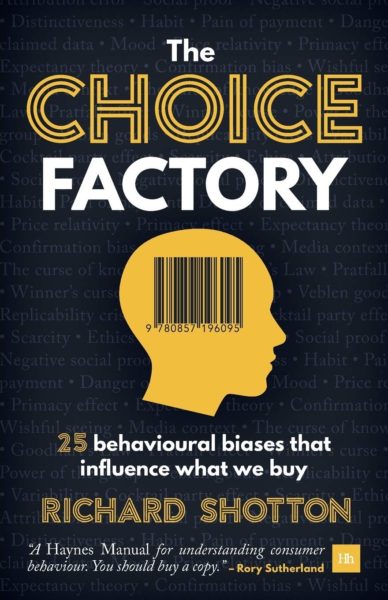
Book: The Choice Factory
Synopsis – If you are in the business of influencing decisions, you need to understand what drives them. The Choice Factory is an essential read for anyone who wants to learn. Taking us through a typical day of decisions, from trivial food choices to life-changing career moves, The Choice Factory explores how our behaviour is shaped by psychological shortcuts. The focus throughout is the marketing potential of knowing what makes us tick. Shotton draws not only on academia, but also on analysis of ad campaigns and his own original research, supporting his discussion with insights from some of the smartest thinkers in advertising. The Choice Factory is an entertaining and highly-accessible read, with 25 short chapters, each addressing a cognitive bias and outlining easy ways to apply it to your own business challenges. Dip in or read cover to cover and you’ll be full of new ideas, ready to crack any brief.
Rating (1-10) –
Book Review –
Notes:
Chapter 1 – The Fundamental Attribution Error
What it is: The tendency to overestimate the importance of personality, and underestimate that of context, when explaining behavior.
We discount mood, busy-ness, or mindset. I.e. He’s greedy because he the business guy in a suit didn’t get the homeless guy money. It could be that he didn’t have money on him and planned to come back later to give him money.
We “attribute” the wrong reasons for why someone does something.
People rushing aren’t to be bothered. They will have very little recall of your ad.
Brands must identify and then focus their communications on a core target audience
Context in marketing is important to decision making.
Chapter 2 – Social Proof
What it is: You’re interested in something because other people are interested.
How to Apply It:
- Tell people how popular it is.
- Tailor popularity message to your direct audience. State your brand’s popularity in a relevant way.
- David Ogilvy “Consumers don’t think how they feel, say what they think or do what they say”
- Asking customers for feedback can actually be misleading. Real world experiments will give you the best data.
- Most people don’t know your scale. Tell them about it.
- Creatively tell people about your scale. Use social proof with charm and wit. Facts aren’t important. Create the illusion of popularity.
- Social proof works so use it even if you think it’s too simplistic.
Chapter 3 – Negative Social Proof
What it is: Using social proof to encourage a behavior you don’t want by emphasizing how many other people are doing what you don’t want people to do.
How to apply it:
- Flip the statistics. Instead of saying how many people are doing a negative thing, tell them how many people are doing what you want. I.e. 97% of customers don’t steal.
Chapter 4 – Distinctiveness
What it is: Stand out from the crowd helps people remember you more.
How to apply it:
- Discover what most people in your category are doing and subvert them. If something feels safe in advertising then it’s probably a bad sign because safe is what everyone else is doing.
- Large committees deciding marketing decisions usually output bland work because of consensus.
- Younger people are more prone to notice distinctiveness.